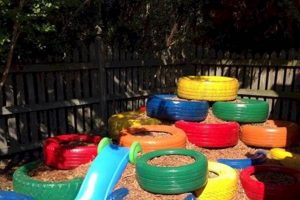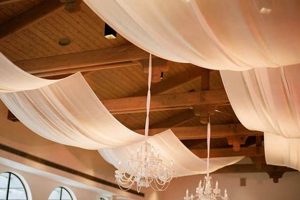The concept involves crafting illumination solutions powered by the sun’s energy using readily available materials and individual ingenuity. An example of this application is the repurposing of glass jars and miniature solar panels to create ambient garden lighting.
Such self-sufficient lighting projects offer considerable advantages, including reduced electricity consumption and a corresponding decrease in energy costs. Historically, these initiatives represent a shift towards sustainable practices and resourcefulness in home improvement. The ability to create custom lighting addresses both environmental concerns and personal aesthetic preferences.
The following sections will detail specific design concepts, material considerations, and construction techniques applicable to creating personalized outdoor lighting using renewable solar energy. These instructions aim to provide individuals with the knowledge to undertake their own projects effectively and safely.
Essential Considerations for Solar-Powered Illumination Projects
The following guidelines provide key considerations when planning and executing illumination projects driven by photovoltaic energy. Adherence to these recommendations will maximize efficiency and longevity of constructed lighting elements.
Tip 1: Optimize Solar Panel Placement: Ensure the photovoltaic cell receives direct sunlight for a minimum of six hours daily. Southern exposure is generally preferable in the northern hemisphere.
Tip 2: Select Appropriate Battery Capacity: Choose a rechargeable battery with adequate storage capacity to power the light source throughout the desired illumination period. Consider local weather patterns when determining capacity needs.
Tip 3: Weatherproof All Components: Use sealant and durable materials to protect electrical connections and the lighting fixture itself from moisture and environmental damage. Prolonged exposure to the elements can significantly reduce lifespan.
Tip 4: Utilize Energy-Efficient Light Sources: Opt for LED bulbs to minimize energy consumption and maximize runtime on a single charge. LEDs also generate less heat, improving safety and efficiency.
Tip 5: Regularly Maintain the Solar Panel: Clean the surface of the photovoltaic cell periodically to remove dust and debris that can impede light absorption. A clean panel ensures optimal energy generation.
Tip 6: Consider Automatic On/Off Functionality: Implement a light sensor or timer to automate the activation and deactivation of the illumination, conserving battery power and providing convenience.
Tip 7: Securely Mount Lighting Fixtures: Employ robust mounting hardware and techniques to prevent accidental dislodgement of the lighting unit due to wind or other external factors. Safety is paramount.
These tips provide crucial guidance for successful integration of solar energy into outdoor lighting solutions. By prioritizing strategic component selection, meticulous construction, and consistent maintenance, users can maximize the benefits of these lighting systems.
The subsequent sections will explore specific design strategies, addressing aesthetic integration and providing detailed guidance on constructing safe and effective solar-powered illumination.
1. Light Output
Light output, quantified in lumens, serves as a critical determinant of the effectiveness of any solar-powered illumination project. When engaging in such activities, understanding the correlation between the light-emitting diode (LED) rating and the size of the photovoltaic cell is essential. A mismatch can lead to either insufficient illumination or premature battery depletion. For example, a pathway requiring substantial lighting needs high-lumen LEDs, requiring a larger solar panel to adequately charge the battery during daylight hours. Conversely, decorative lighting with lower lumen requirements needs smaller and less expensive panels.
The choice of light output directly impacts the visual effectiveness and the functional purpose of the lighting installation. For instance, security lighting necessitates higher light output to deter potential intruders. Ambient lighting, conversely, may utilize lower light levels to create a relaxing atmosphere. The selection of LEDs, therefore, must be based on a clear understanding of the intended application and its corresponding lighting needs. Improper assessment of light output leads to dissatisfaction and necessitates costly revisions to the project.
In conclusion, appropriate light output is not merely a superficial aspect of solar lighting projects; it influences the selection of all other components, from the solar panel capacity to the battery size. Selecting an LED with an inappropriate light output significantly undermines the efficiency and utility of the entire lighting design. By carefully evaluating the necessary illumination level, one can optimize the performance and overall satisfaction derived from the installed system.
2. Battery Capacity
Battery capacity is a foundational element in the successful execution of self-assembled solar-powered lighting projects. It directly dictates the duration and intensity of illumination achievable during periods of darkness or limited sunlight. Insufficient battery capacity results in diminished lighting duration and may necessitate frequent replacements, thereby increasing operational costs. Conversely, excessive battery capacity increases initial expenditure without necessarily enhancing functional performance. Consequently, proper assessment and selection of battery capacity are paramount. The energy storage capacity of the battery must align with the power consumption of the lighting element, typically an LED, and the average daily sunlight exposure available for recharging. For example, garden lights intended to operate throughout the night require batteries with higher milliamp-hour (mAh) ratings compared to those designed for shorter durations.
Practical applications of this understanding extend to diverse lighting scenarios. Walkway lights, perimeter lighting, and decorative accents each demand specific considerations regarding battery size and type. Lithium-ion batteries are commonly employed due to their high energy density and extended lifecycles, while nickel-metal hydride (NiMH) batteries offer a more cost-effective alternative, albeit with lower performance characteristics. Furthermore, environmental factors, such as temperature extremes, can impact battery performance. Cold temperatures reduce battery capacity, requiring users in colder climates to select batteries with increased capacity to compensate for performance degradation. Proper battery selection and maintenance optimize the operational lifespan and reliability of self-constructed solar lighting systems.
In summary, battery capacity represents a critical determinant of the efficacy and longevity of solar
lighting projects. The challenge lies in accurately matching battery specifications to lighting requirements and environmental conditions. By carefully evaluating these factors, individuals can optimize system performance, minimize operational costs, and contribute to sustainable illumination practices. Failure to adequately address battery capacity invariably leads to operational inefficiencies and premature component failure, thereby negating the intended benefits of renewable energy utilization.
3. Weather Resistance
The durability and long-term functionality of photovoltaic-powered illumination systems are intrinsically linked to their capacity to withstand environmental elements. The effectiveness of self-assembled outdoor lighting configurations heavily depends on the ingress protection offered by the assembly. The absence of appropriate measures results in water damage, corrosion, and subsequent system failure. For instance, a poorly sealed electrical connection exposes conductive elements to moisture, resulting in short circuits or complete operational cessation. This interdependency highlights the critical role weather-resistant design plays in prolonging the lifespan and enhancing the reliability of these lighting systems.
Practical applications necessitate careful material selection and meticulous assembly techniques. Enclosures constructed from UV-resistant polymers, coupled with watertight seals, mitigate the detrimental effects of prolonged exposure to sunlight and precipitation. The use of corrosion-resistant hardware, such as stainless steel fasteners, prevents structural degradation, thus ensuring long-term stability. Furthermore, protective coatings applied to sensitive electronic components provide an additional layer of defense against humidity and airborne contaminants. These strategies directly contribute to enhanced operational reliability and reduced maintenance requirements.
Ultimately, the integration of robust weather-resistant features represents a fundamental aspect of successful illumination projects driven by photovoltaic power. Neglecting these factors compromises system integrity, leading to premature failure and negating the economic and environmental benefits of renewable energy utilization. By prioritizing resilient design principles and rigorous construction methods, one maximizes the performance and longevity of these systems, achieving sustainable and cost-effective lighting solutions.
4. Design Aesthetics
The visual appeal of illumination solutions directly influences their integration into outdoor environments. The practical application of self-built outdoor lighting extends beyond mere functionality; it encompasses the capacity to complement architectural styles and enhance landscape design. Therefore, the aesthetics of these lighting elements are not secondary considerations but integral components impacting overall project success. A poorly designed lighting fixture, irrespective of its functional capabilities, diminishes the visual harmony of its surroundings. For example, a modern, minimalist dwelling would likely be visually discordant with traditionally styled, ornate lighting fixtures.
The integration of aesthetically driven considerations into the construction process requires careful evaluation of materials, forms, and light dispersion characteristics. Repurposing glass containers offers opportunities to create unique, ambient lighting effects. Similarly, utilizing metalworking techniques allows the fabrication of geometrically complex structures. Color temperature selection also affects the mood and visual perception of the illuminated space. Warmer light temperatures typically evoke feelings of comfort and relaxation, while cooler temperatures may be more appropriate for task lighting or security applications. Successful designs consider these factors holistically to achieve cohesive integration.
Consequently, design aesthetics are not superfluous additions to self-constructed, solar-powered lighting but essential parameters that determine their effectiveness within specific environments. The integration of aesthetically pleasing elements fosters a sense of visual coherence, enhancing the overall value of the lighting installation. Attention to these elements contributes to long-term user satisfaction. The challenges lie in balancing cost-effectiveness with aesthetic aspirations; however, prioritizing design considerations ultimately improves the quality and appeal of the lighting solutions.
5. Component Cost
The financial outlay required for components exerts a substantial influence on the accessibility and feasibility of self-assembled solar lighting projects. The overall expense is determined by the selection of constituent elements, including photovoltaic cells, batteries, light-emitting diodes (LEDs), enclosures, and associated hardware. Increased cost can reduce the attractiveness of these projects, particularly for individuals with budget constraints. For example, a high-efficiency solar panel significantly enhances energy conversion but also elevates the overall system cost compared to standard-efficiency alternatives. This interrelation necessitates careful planning to achieve the desired functionality within a defined financial framework.
Furthermore, the cost-benefit analysis of implementing solar-powered lighting requires evaluating long-term savings against initial investment. While the elimination of electricity bills represents a tangible advantage, the upfront expenditure on components can present a barrier to entry. Sourcing materials from different vendors, employing repurposed components, or opting for standard rather than premium grade materials can mitigate expenses. For instance, utilizing reclaimed glass jars as enclosures reduces cost while promoting sustainable reuse. The impact of material choice on the overall cost and lifespan of the completed product must be carefully considered to optimize value.
In summary, component cost constitutes a critical factor determining the practicality and adoption of self-built solar lighting solutions. Striking a balance between budgetary limitations and performance requirements ensures the financial viability of these projects. Optimizing component selection and procurement processes enables individuals to realize the benefits of renewable energy while adhering to established financial parameters. This approach promotes the democratization of sustainable lighting technologies, making them accessible to a broader audience.
6. Panel Placement
The efficacy of do-it-yourself solar light projects hinges substantially on strategic positioning of the photovoltaic cell. Placement directly impacts energy absorption, influencing both the operational duration and intensity of the illumination. Suboptimal positioning diminishes light-harvesting capabilities, resulting in reduced performance and negating intended sustainability benefits.
- Orientation Relative to Sunlight
Orientation dictates the incident angle of solar
radiation upon the panel’s surface. Optimal orientation maximizes direct sunlight exposure, typically requiring a southward facing position in the Northern Hemisphere. Deviations from this ideal result in reduced energy capture. Example: A panel facing east receives optimal sunlight in the morning but experiences diminishing returns throughout the afternoon. - Angle of Inclination
The angle at which the panel is tilted relative to the horizontal plane directly affects energy capture. The optimal angle is generally equivalent to the local latitude. Variations from this ideal necessitate seasonal adjustments to maximize solar gain. Example: A panel fixed at a shallow angle during summer months underperforms during winter due to reduced sunlight hours and a lower solar angle.
- Obstruction Mitigation
The presence of shading obstructions, such as trees or buildings, limits direct sunlight exposure. Shading leads to reduced energy generation and diminished operational efficiency. Mitigation involves strategic positioning to minimize shading effects or employing techniques such as bypass diodes to circumvent shaded cells. Example: A panel partially shaded by a tree limb generates significantly less energy compared to a fully illuminated panel.
- Environmental Considerations
Ambient temperature and atmospheric conditions influence panel performance. Elevated temperatures reduce efficiency, while dust accumulation impedes light absorption. Strategic placement can mitigate temperature extremes, while regular cleaning ensures optimal light capture. Example: A panel mounted in a poorly ventilated area experiences reduced efficiency due to overheating during peak sunlight hours.
These facets highlight the interconnectedness between proper panel placement and the ultimate success of solar-powered lighting. Effective integration requires a comprehensive understanding of sunlight patterns, environmental factors, and mitigation strategies to maximize energy harvesting and ensure consistent, reliable illumination. Correct panel placement is not merely a preliminary step but a continuous process of assessment and adjustment to optimize performance over time.
Frequently Asked Questions About Solar Lighting Projects
The following addresses common inquiries regarding the design, construction, and maintenance of self-assembled solar-powered illumination systems.
Question 1: What is the typical lifespan of a photovoltaic cell used in illumination projects?
Photovoltaic cells typically maintain a performance level of 80% of their initial output after 25 years. Factors affecting lifespan include climate conditions, manufacturing quality, and panel maintenance.
Question 2: How does battery capacity impact the duration of illumination?
Battery capacity, measured in amp-hours (Ah) or milliamp-hours (mAh), determines the length of time a light can operate without solar charging. Higher capacity allows for extended illumination during periods of low sunlight.
Question 3: What materials provide effective weather resistance for outdoor lighting fixtures?
Materials such as UV-resistant polymers, stainless steel, and sealed enclosures protect internal components from moisture, corrosion, and environmental degradation. Proper sealing is crucial for longevity.
Question 4: How should optimal placement of the solar panel be determined?
Optimal positioning involves facing the panel south (in the Northern Hemisphere) at an angle approximating the local latitude. This maximizes direct sunlight exposure throughout the year, improving energy capture.
Question 5: Are there safety precautions to consider when building outdoor illumination systems?
Safety practices include proper wiring techniques, grounding of electrical components, and the use of appropriate fuses to prevent electrical hazards. Consult local electrical codes for compliance.
Question 6: What are the most energy-efficient light sources for illumination projects?
Light-emitting diodes (LEDs) offer high efficiency, long lifespans, and low power consumption compared to incandescent or halogen bulbs, maximizing run time from available solar energy.
These responses underscore the importance of informed decision-making in developing effective and enduring outdoor lighting solutions powered by the sun.
The next section discusses specific construction techniques and project examples.
Conclusion
The preceding exploration demonstrates that “diy solar light ideas” represent a tangible means of harnessing renewable energy for practical illumination. Effective implementation requires meticulous attention to detail, encompassing strategic component selection, robust construction techniques, and conscientious panel placement. The interdependency between these factors determines overall system performance and longevity.
The information presented provides a foundation for individuals to create personalized and sustainable outdoor lighting solutions. Continued advancement in photovoltaic technology and further refinement of self-assembly methodologies promise enhanced efficiency and affordability, contributing to the widespread adoption of “diy solar light ideas” as a viable alternative to conventional electrical illumination.







